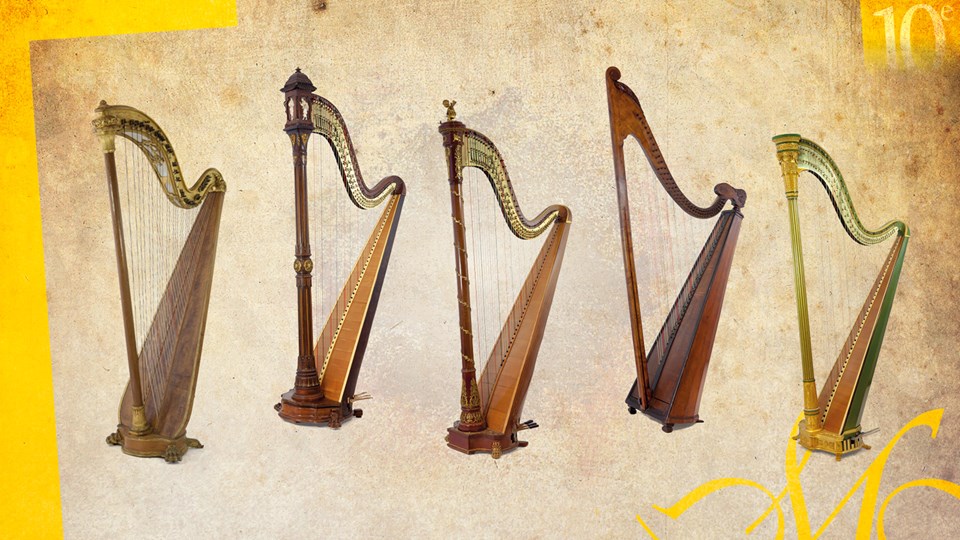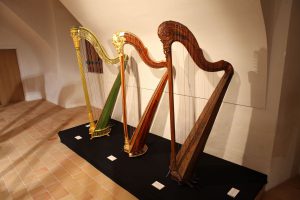Camac Blog
The Early Pedal Harp as a Museum Artefact – Munich, November 2018
Latest
January 3, 2019
London, 1800. In the course of one century, the city’s capital was to expand from one million people (1801), to 6.2 million by 1900. It was the world’s largest city, and capital of the British Empire. A newly-wealthy middle class was emerging from the forefront of the Industrial Revolution. Unlike France, reeling from a different Revolution of their own, Britain was also still bustling with nobleman. Free trade overtook mercantilism, with ever-increasing foreign exchange. Manufacturers had fiercely to compete, as evidenced by the vigorous applications for and sales of patents, and equally fierce litigation cases. London in 1800, like many societies in times of boom, spent lavishly, experienced high inflation, and ran – therefore – on credit. An elaborate system of cash loans, credit notes, investors, and their associated and complex permutations of trust underpinned the solvency of both businesses, and clients.
It was into this colourful maelstrom that Sébastien Erard arrived, from Paris in 1792. By 1813, the Paris branch of the Erard firm had gone bankrupt, certainly unaided by the French Revolution and the Reign of Terror (this included a search, terrifying indeed, in 1793 of the Paris Erard workshops by the comité de surveillance, and which could have led Jean-Baptiste Erard to the guillotine). The London Erard branch, meanwhile, went from strength to strength. From the beginning, the premises in Great Marlborough St had been entirely dedicated to the harp – unlike in Paris, where they sold pianos as well – and therefore naturally became a go-to address for the instrument. A string of English patents protected Erard’s inventions. Pierre Erard, marketing whizz, was also assiduous in suing business rivals, even once challenging Dizi to a pistol duel (Dizi wisely apologised; Pierre was a good shot). By 1810, the market was thriving, ready for the launch of the double-action harp.

L-R: Pleyel Chromatic harp n° 262 (Paris, 1901); Erard n°2398, Japanese model (Paris, 1894); n°3969, Erard Empire model with Cupid (Paris, 1914); Henessy Hughes Welsh triple harp (Llandudno, Wales, 1896); Naderman Single-action harp n° 301, with forked discs (Paris, after 1820)
One such harp, Erard no. 2631 (1818) is now in the Deutsches Museum in Munich. The DM has always been both an exhibit space, and also an active research centre into technology, science and their cultural resonances. The museum’s Research Institute for the History of Science and Technology is currently running a project, lead by Panagiotis Poulopoulos and supported by the Volkswagen Stiftung, called “A Creative Triangle of Mechanics, Acoustics and Aesthetics: The Early Pedal Harp (1780-1830) as a Symbol of Innovative Transformation“. No.2631 has thereby become a focal point for research into the Erard harp in Regency London.
Poulopoulos and his research team recently organised a conference entitled “The Early Pedal Harp as a Museum Artefact: Research – Conservation – Presentation”. Robert Adelson (Conservatoire à Rayonnement Régional de Nice), curator of our own historical collection, focused on the history of Erard’s development of the double-action mechanism. Erard, through his own inventions and by improving those of others, created the first functional double-action harp. Double actions had existed before, but it was this functionality which allowed it to be adopted seriously by professional musicians, who needed to earn their living at the instrument. Erard bought Cousineau’s fourteen-pedal harp in the 1790s, for his own study; he worked on perfecting the single-action harp at the same time as continuing his experiments into the double-action; and he bought – in great haste and at vast expense – Charles Gröll’s patent for a double-action mechanism in 1808, which he then further improved. “If Erard is the father of the double-action harp”, Robert Adelson remarked, “then Gröll is its Polish uncle.”
Sébastien Erard is often named the inventor of the double-action harp, but he was no solitary genius; people rarely are. It is important to connect one piece of history with another, because it often alters the picture. Mike Baldwin (London Metropolitan University) identified the need for a common descriptive language for the early pedal harp, without which it is difficult to avoid cataloguing errors, or to compare instruments. Christopher Clarke (Donzy-le-National) compared Sébastien Erard’s innovations in harp making, with those in his pianos; Lewis Jones (London Metropolitan University) analysed the stringing of the London-made harp at the start of the nineteenth century. We also learnt about the X-ray and other low-impact techniques employed by the team at the Deutsches Museum to examine no. 2631. These revealed, among other things, that Erard applied varnish before the first layer had dried completely. He also seems to be the first harp maker to have used découpage techniques to decorate his harps, and further X-rays reveal his extended use of pre-molded composition ornaments, then fixed onto the harp. These observations all suggest a need to work more quickly, with a view to serial production. The study of an instrument’s build also illuminates the market conditions of the day.
Moving towards the question of the musical marketplace, Julin Lee (Ludwig Maximilian University of Munich) analysed the ledgers of Erard London in 1818. You can see, for example, from the monthly turnover rate which harps were sold from stock and which were freshly-made – a question of great interest for harp makers today, who must also juggle stock, production, and try to predict demand. Julin Lee is also cataloguing surviving Erard harps, to gather their various locations today and (again) to improve connections and comparisons between them. Jenny Nex (Musical Instrument Museums, Edinburgh) provided an overview of the London Erard’s financial activities. These revealed complex relationships with debtors and creditors, and an increasing fall in sales to the nobility; they were replaced by those to professional musicians and the middle classes. Fanny Guillaume-Castel (Pantheon-Sorbonne University) also examined the early pedal harp as an economic commodity, similarly noting the steady increase in professional clients. At one point, 40% of Erard’s sales were to intermediaries, for example Bochsa, who was buying the harps for other people. Maria Christina Cleary shone a more detailed spotlight on Bochsa, whose harpistic talent and shrewd understanding of the musical marketplace brought him considerable success – despite a succession of personal challenges, such as having to flee Paris for London to escape creditors, being sentenced to twelve years of hard labour by the French authorities for forging the signatures of famous composers, and being married bigamously.
The early pedal harp is particularly interesting not only because of its intricate mechanical development, but also its elaborate decoration. The technical innovations the early pedal harp enjoyed ensured its place in the modern orchestra, and a continuing role in Western art music. Equally, by dint of beautiful appearance and high cost, it retained its role as a luxury object. Design historian Eve Zaunbrecher (New Orleans) linked the eighteenth-century harp to the fine furniture trade, and also looked at the profound feminisation of the instrument at the same time. These complex associations continue today, the modern harp being the only instrument still to be highly decorated. Certainly, this is something of a double-edged sword. On the one hand, every fine harp decoration is a labour of love on the part of the maker and received the same way by the harpist. On the other, looking like furniture can lead to being treated as such; even today, not every composer, concert promoter or critic takes the harp seriously. The design of an instrument, the associations this evokes and the development of its repertoire and cultural position can never be separated, and this process is always also extramusical.
Every high school student who has written their “why do we study history?” essay knows that one reason is to inform the present. Yet human adults are dreadful at remembering the lessons of history; if they weren’t, there would be no wars, or right-wing populism. In every context, also in music, the separation between past and present is entrenched. Historically-informed performance practice is a specialist niche. Where the historically-informed lies outside the mainstream, our contemporary norm is to perform uninformed. The HPP movement also has a responsibility to address the gulf, by identifying and communicating their relevance to modern performance. Mediocre juries will sometimes throw out an interpretation for being “inauthentic”, but only to accept a performance exactly as (you suppose) it would have been done hundreds of years ago, reveals a limited grasp of the value of tradition.
In the concluding lecture at the Munich conference, Thierry Maniguet (Musée de la Musique and CNSM, Paris), who curates a collection of sixty-one harps, remarked on the need to buy exhibits to preserve the story for the next generation – and sometimes quickly, before it becomes impossible to acquire a particular instrument. This dynamic reactivity, mindful of the present and future as well as the past, is central to the best museums. Panagiotis Poulopoulos explained how, as he approached his Erard no. 2631, an enormous frame of reference was quickly unleashed by one single instrument. Object-based research, archival research, musicology, social and economic history, the history of science, technology and the fine and applied arts, contextualisation…and many other factors rushed into the field, and are again what makes this kind of study fruitful. Nobody can be expert in everything, but the interrogations result in ever-increasing awareness, and different specialists come together in the interests of quality, and ultimately a stronger cultural position for the arts. We are grateful to the Deutsches Museum and the Volkswagen Foundation for having made it possible for us to benefit from these enlightening sessions of interdisciplinary exchange.

